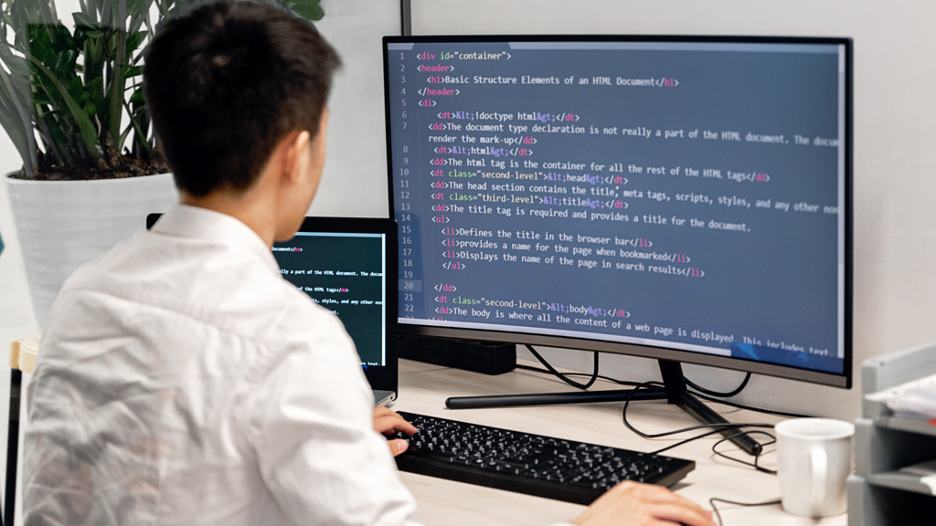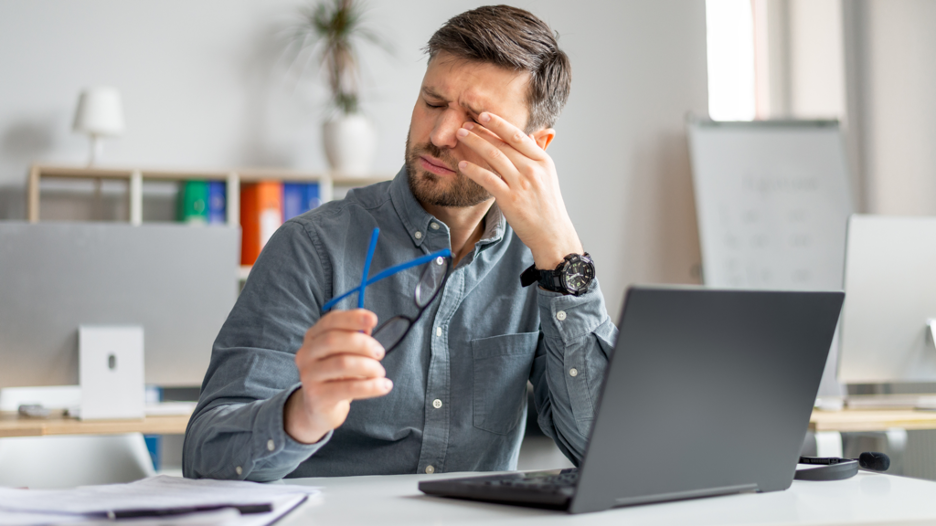Whether you’re coding at the downtown tech hub, checking invoices in an open‑concept office, or brainstorming at a co‑working table, screens rule the day. Long stretches under harsh office lighting and poor desk setups spark digital eye strain symptoms—dryness, headaches, blurry text, and even aching necks.
Most eye discomfort at work comes from fixable setup issues, not just the screen itself. Here are some tips for you to tweak the space and feel relief fast.
The 20‑20‑20 Rule
Think of this as quick yoga for your eyes. Every 20 minutes, look at something about 20 feet (6 metres) away for at least 20 seconds. Those numbers give the tiny focusing muscles inside your eyes a full release, like dropping a heavy backpack after a hike.
- Pair it with routine tasks: Every time you hit “Send,” lean back, find the farthest exit sign or tree outside, and breathe slowly while you blink ten times.
- Automate the reminder: Free browser extensions or phone apps such as EyeCare 20‑20‑20 flash a subtle pop‑up so you’re not watching the clock.
- Stack on a stretch: While your gaze is in the distance, roll your shoulders, shrug twice, and gently tilt your neck side‑to‑side. You’re resetting vision and posture in one shot.
Why the Slow Blink Matters
Screens chop our natural blink rate from about 15 times a minute to fewer than five. Fewer blinks = less moisture, scratchy corneas, and that gritty “sand in the eye” feeling by 3 p.m. A conscious, lazy blink spreads fresh tears across the surface—think of it as windshield fluid for your eyeballs.
Pro tip for contact‑lens wearers: Keep preservative‑free lubricating drops at your desk. One drop every coffee break pairs perfectly with the 20‑20‑20 rhythm and keeps lenses comfy till quitting time.
Master Your Monitor Placement

Your monitor isn’t just another piece of hardware—it’s where your eyes spend most of the day. Dial in its position and you’ll notice crisper text, calmer shoulders, and far fewer end‑of‑day headaches. Keep these quick measurements in mind:
- Distance: Keep screens about an arm’s length (50–70 cm) away.
- Height: The top edge should sit at, or just below, eye level so lids naturally lower and reduce surface exposure.
- Angle: Tilt the monitor slightly back (10–15°) to cut reflections.
- Dual screens: Centre yourself or angle them evenly so you’re not craning your neck all day.
Quick win: Dropping your chair instead of lifting the monitor sometimes does the trick.
Tame Harsh Glare with Smart Accessories
Even the best‑placed monitor can look like a mirror when overhead LEDs or sunny windows hit just right. Before you juggle furniture, grab one of these quick‑fix tools:
- Anti-glare screen protector—a matte film that slashes reflections by up to 90 %.
- Polarized clip‑ons if you work near big windows.
- Desk lamp with adjustable brightness—shoot for 300–500 lux on paperwork.
Lighting Layers That Save Your Sight
Good lighting isn’t just about brightness, it’s about balance. Think of your workspace lighting like layers working together to create a comfortable, glare-free environment. Mixing different light sources can help reduce eye strain and keep you focused throughout the day.
- Ambient: Soft overhead LEDs or fluorescents that spread light evenly.
- Task: A flexible lamp aimed at documents, not your eyes.
- Accent: Window daylight filtered through sheer blinds to cut UV glare.
Swap cold‑blue bulbs for warm white (3000–3500 K) to curb fatigue.
Device Settings Most People Ignore
Dialling in display settings is the fastest facelift for tired eyes—no new gear required. Spend a minute on the tweaks below and reap hours of crisp, comfortable viewing:
| Setting | Why It Matters | Best Practice |
| Brightness | Too bright forces squinting; too dim strains focus | Match the screen brightness to the surrounding light |
| Colour temperature | Blue light late in the day disrupts sleep | Use night‑shift mode after 7 p.m. |
| Text size & contrast | Small fonts = constant leaning | Set body text ≥ 16 px; high contrast black‑on‑white |
| Refresh rate | Flicker can trigger headaches | Choose 75 Hz+ if your monitor allows |
Posture: Eyes Follow Your Spine
Slouchy backs push heads forward, bringing eyes closer than intended.
- Chair: Feet flat, lumbar support snug.
- Desk height: Elbows at 90°, shoulders relaxed.
- Document holder: Stand papers upright beside the monitor to avoid refocusing every second.
Add a small desktop humidifier or leafy plant; Ontario winters get dry and can worsen digital eye strain.
Nutrition and Hydration on the Job
Your eyes don’t just work hard—they need good fuel and plenty of hydration to stay sharp and comfortable throughout the day. What you eat and drink can have a big impact on how your eyes feel, especially when you’re glued to screens.
Start by reaching for snacks and meals packed with eye-friendly nutrients to avoid digital eye strain:
- Omega-3 fatty acids found in walnuts, flaxseeds, and chia seeds help reduce inflammation and keep your eyes’ tear film stable. Grab a small handful of walnuts or flax crackers during your breaks to give your eyes a boost.
- Stay hydrated by aiming to drink at least one glass of water every hour. Dehydration dries out your eyes, making them itchy and uncomfortable, especially in heated or air-conditioned spaces.
- Leafy greens like spinach, kale, and Swiss chard are rich in lutein and zeaxanthin—antioxidants that protect your retina from harmful light exposure. Add a fresh salad or sautéed greens to your lunch or dinner for long-term eye health.
- Vitamin C and E, found in citrus fruits, bell peppers, nuts, and seeds, support healthy blood vessels in your eyes and may lower the risk of cataracts and macular degeneration.
- Carrots and orange vegetables are rich in beta-carotene, a form of vitamin A that helps maintain good vision, especially in low light.
Remember, balanced nutrition works best alongside regular hydration. Together, they keep your eyes well-lubricated and resilient against the strain of long workdays.
When DIY Fixes Aren’t Enough

Persistent dryness, double vision, or headaches could signal underlying problems like uncorrected astigmatism or chronic dry eye. That’s when you call the pros. At LMC Optometry & Eye Care, our Ontario‑based team can:
- Run a full eye‑strain assessment.
- Check tear‑film quality and binocular vision.
- Prescribe tailored solutions—lubricating drops, specialty lenses, or vision therapy.
Red Flags—Book an Appointment ASAP
- Sudden vision changes.
- Painful, red eyes that don’t clear up overnight.
- Flashes, floaters, or halo rings.
Ready for Clear, Comfortable Vision All Day?
Tiny tweaks now can spare you years of discomfort. If your eyes still rebel after trying these tips, let’s figure it out together.
Book a zero‑pressure health exam with LMC Optometry & Eye Care. Our Ontario clinics will fine‑tune your vision for any desk setup—no pushy sales talk, just clear answers.
Click here to schedule or shoot us a question—your eyes will thank you.



